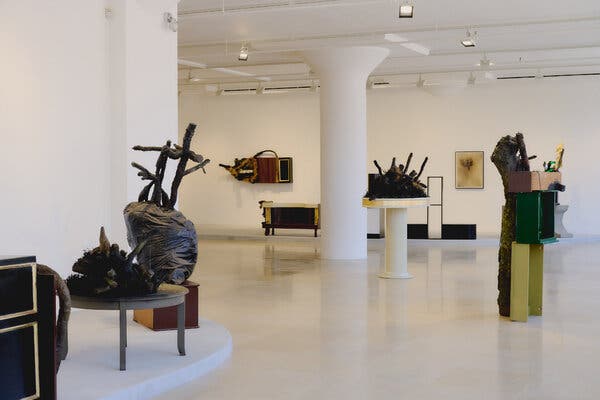
There wasn’t much free ground on which to stand in Brandon Ndife’s Brooklyn studio. Nearly every inch of the space had been swallowed up by a wild profusion of sculptures, which rose from the floor like a dense, unruly forest. The artworks heaved with his facsimiles of botanical life — tree trunks, branches, wheat, vines and vegetables. Twisting and torquing, this biotic matter appeared to be devouring the very things that it had emerged from: quotidian household objects and furniture.
It was a bewildering fusion of the domestic interior and the natural exterior, one that pierces with the chill of the uncanny. In this bewitched ecology, kitchen tiles wretch up tree branches and raffia (“Backsplash”), while winding tree trunks choke cabinets (“Untitled”). Elsewhere, grass sprouts from a table rimmed with gold (“Golden Buffet”).
What created this world? Do the sculptures describe the remnants of a long-abandoned property? The aftermath of an apocalyptic event? The vengeful rebellion of plants against humankind and our cavalier treatment of the earth? However you choose to interpret them, the artworks bear the residue of a struggle, a reordering of things.

“I imagine that they’re coming from these far-fetched, very ethereal places,” Ndife said. “The work is both recognizable and disturbing.” Despite the foreboding tone that shadows his work, the artist is an inviting speaker, with a cadence that balances conviction and warm enthusiasm.
Peering into the dark, strange world evoked in Ndife’s artworks, the optic nerve begins to
squirm. The sculptures are unsettling, and Ndife, 33, also wants viewers to interrogate why they find them unsettling, to reckon seriously with our tendency to fear that which we cannot control.
 Print
Print




